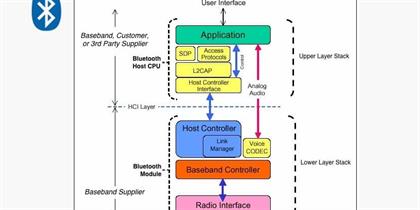
Understanding the Bluetooth Low Energy Physical Layer
September 11, 2024
 Bluetooth Low Energy (BLE) has become a cornerstone technology for wireless communication, particularly in the realm of the Internet of Things (IoT). At the heart of BLE’s efficiency and reliability is the Physical Layer (PHY), which handles the fundamental task of transmitting and receiving data over the air. This article delves into the intricacies of the BLE PHY, exploring its specifications, challenges, and innovations that make BLE a preferred choice for countless applications.
Bluetooth Low Energy (BLE) has become a cornerstone technology for wireless communication, particularly in the realm of the Internet of Things (IoT). At the heart of BLE’s efficiency and reliability is the Physical Layer (PHY), which handles the fundamental task of transmitting and receiving data over the air. This article delves into the intricacies of the BLE PHY, exploring its specifications, challenges, and innovations that make BLE a preferred choice for countless applications.
The Essence of the Physical Layer
The Physical Layer is the foundation of any wireless communication protocol, including Bluetooth LE. It defines the basic parameters for the transmission of raw data bits over the air. In the context of BLE, the PHY is responsible for modulating the data onto a carrier signal, transmitting it through the antenna, and then demodulating the received signal at the other end. This process involves a series of complex operations, including encoding, modulation, signal processing, and error detection.
Frequency Band and Channelization
One of the primary responsibilities of the BLE PHY is to define the frequency band and channelization used for communication. BLE operates in the 2.4 GHz Industrial, Scientific, and Medical (ISM) band, which is a globally available, license-free frequency band. This band is divided into 40 channels, each spaced 2 MHz apart. The choice of channels is strategic, as it allows BLE devices to coexist with other wireless technologies that operate in the same frequency band, such as Wi-Fi and other Bluetooth devices.
Modulation Schemes
Modulation is the process of varying a carrier wave to encode information. BLE uses Gaussian Frequency Shift Keying (GFSK) as its primary modulation scheme. GFSK offers a good balance between spectral efficiency and robustness against noise and interference, which is crucial for the reliable operation of BLE devices in crowded radio environments. The BLE PHY also supports other modulation schemes, such as Differential Phase Shift Keying (DPSK) and 8DPSK, which can be used to optimize performance based on specific application requirements.
Transmission Power and Sensitivity
The BLE PHY also specifies the transmit power levels and receiver sensitivity. Transmit power levels can range from a minimal 0 dBm (1 mW) to a maximum of +10 dBm (10 mW), although these values can be adjusted based on the application’s range requirements. Receiver sensitivity, on the other hand, is a measure of the minimum signal strength that a BLE device can reliably detect and demodulate. High sensitivity is essential for maintaining a strong connection, especially at the edge of a device’s communication range.
Error Detection and Correction
Given the inherently noisy and unpredictable nature of wireless communication, error detection and correction are vital aspects of the BLE PHY. BLE employs techniques such as Forward Error Correction (FEC) and Cyclic Redundancy Check (CRC) to ensure data integrity. FEC adds redundant data to the transmitted signal, allowing the receiver to correct errors without the need for retransmission. CRC, on the other hand, is a checksum used to detect errors in the received data. If an error is detected, the receiver can request a retransmission of the corrupted data packet.
Power Consumption Optimization
Power consumption is a critical concern for BLE devices, which often operate on battery power. The PHY layer plays a significant role in optimizing power usage. By employing techniques such as duty cycling, where the radio is only active for short periods to transmit or receive data, BLE devices can conserve energy. The PHY also supports low-power modes, where the device can enter a sleep state to conserve battery life while still being able to receive incoming connections or data.
Challenges and Innovations
Despite its robust design, the BLE PHY faces challenges such as interference from other wireless devices, multipath fading, and signal attenuation due to obstacles. To overcome these, continuous innovations are being made. For example, adaptive frequency hopping can be used to avoid frequency channels with high interference. Additionally, the use of advanced signal processing techniques, such as beamforming and antenna diversity, can improve the signal quality and range.
The Road Ahead for BLE PHY
The future of the BLE PHY looks promising with ongoing research and development aimed at enhancing its capabilities. Emerging technologies such as Bluetooth 5.3 and beyond are expected to bring improvements in data rates, range, and reliability. Additionally, the integration of BLE with other wireless technologies, such as Wi-Fi and cellular networks, will further expand the horizons of wireless communication.
Conclusion
The Physical Layer of Bluetooth Low Energy is a testament to the meticulous engineering that goes into making wireless communication possible. It is a complex interplay of electronics, signal processing, and communication theory that enables the seamless exchange of data between devices. As BLE continues to evolve, the PHY layer will remain at the forefront of innovation, ensuring that BLE remains a leading choice for wireless connectivity in the IoT era and beyond.
Leave a Reply
Related Products
You Might Like Also

In the intricate world of Bluetooth Low Energy (BLE) communications, the Generic Attribute Profile (GATT) plays a pivotal role in defining the structure and methods for data exchange. Central to this are the processes of Notifications and Indications, which are the primary means by which GATT servers update clients about changes in attribute values Read More

Central to BLE’s functionality is the BLE Generic Attribute Profile (BLE GATT), which serves as the protocol’s backbone, enabling efficient and structured data communication between devices. This article aims to provide an in-depth exploration of GATT, its components, and its role in BLE technology. Read More

In the realm of wireless communication, Bluetooth advertising has carved out a niche for itself, becoming an indispensable technology for short-range connectivity. At the heart of Bluetooth functionality lies the advertising process, which is the cornerstone for device discoverability and connection establishment. This article delves into the intri Read More

Bluetooth data structures are the foundational elements that govern how data is packaged, transmitted, and received within the Bluetooth ecosystem. These structures are designed to optimize the efficiency and reliability of wireless communication, ensuring that data is handled effectively across various devices and platforms. Read More

In the intricate world of wireless communication, Bluetooth Protocol Stack has established itself as a cornerstone technology, facilitating seamless connectivity between a plethora of devices. At the heart of this technology lies the Bluetooth protocol stack, a structured set of protocols that govern how devices communicate. One of the most critica Read More

In the intricate world of wireless communication, the Bluetooth Generic Access Profile (Bluetooth GAP) of Bluetooth technology stands as a cornerstone, enabling devices to connect, communicate, and collaborate seamlessly. This article delves into the essence of Bluetooth GAP, its role in establishing connections, and the myriad ways it enhances our Read More











